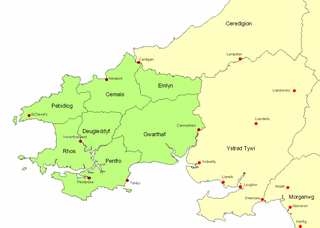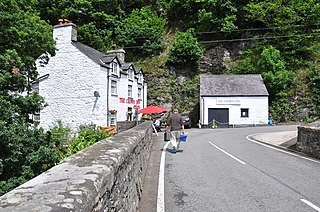Related Research Articles

Hu Gadarn is a supposed Welsh legendary figure who appears in several of a series of Welsh Triads produced by the Welsh antiquarian and literary forger Iolo Morganwg. These triads, which Iolo put forth as medieval works, present Hu as a culture hero of the ancient Britons who introduced ploughing. However, it is now known that the triads, like all of the so-called "Third Series" of triads, were fabricated by Iolo himself. The name "Hu Gadarn" earlier appeared in a Welsh translation of a French romance about Charlemagne. Still, Iolo's version of Hu Gadarn was taken up in the 20th century by the poet Robert Graves, who associated him with other Celtic figures; since then he has been popular among neopagans.

Vortiporius or Vortipor was a king of Dyfed in the early to mid-6th century. He ruled over an area approximately corresponding to modern Pembrokeshire, and Carmarthenshire, Wales. Records from this era are scant, and virtually nothing is known of him or his kingdom. The only contemporary information about Vortiporius comes from the Welsh ecclesiastic Gildas, in a highly allegorical condemnation from his De Excidio et Conquestu Britanniae. At the time the work was written, Gildas says that Vortiporius was king of Dyfed, that he was grey with age, that his wife had died, and that he had at least one daughter.

Edward Williams, better known by his bardic name Iolo Morganwg, was a Welsh antiquarian, poet and collector. He was seen as an expert collector of Medieval Welsh literature, but it emerged after his death that he had forged several manuscripts, notably some of the Third Series of Welsh Triads. Even so, he had a lasting impact on Welsh culture, notably in founding the secret society known as the Gorsedd, through which Iolo Morganwg successfully co-opted the 18th-century Eisteddfod revival. The philosophy he spread in his forgeries has had an enormous impact upon neo-Druidism. His bardic name is Welsh for "Iolo of Glamorgan".
Rhun ap Maelgwn Gwynedd, also known as Rhun Hir ap Maelgwn Gwynedd, sometimes spelt as 'Rhûn', was King of Gwynedd. He came to the throne on the death of his father, King Maelgwn Gwynedd. There are no historical records of his reign in this early age. A story preserved in both the Venedotian Code and an elegy by Taliesin says that he waged a war against Rhydderch Hael of Alt Clut and the kings of Gododdin or Manaw Gododdin. The small scattered settlement of Caerhun in the Conwy valley is said to be named for him, though without strong authority. Rhun also appears in several medieval literary stories, as well as in the Welsh Triads. His wife was Perwyr ferch Rhûn "Ryfeddfawr" and their son was Beli ap Rhun "Hîr".

Rhodri Molwynog, also known as Rhodri ap Idwal was an 8th century king of Gwynedd. He was listed as a King of the Britons by the Annals of Wales.

Owen Jones, known by his bardic name of Owain Myfyr, was a Welsh antiquarian.
Geraint the Blue Bard is a fictional 9th century Welsh bard and harpist, originally purported by Iolo Morganwg to be an historical figure. Geraint has been definitively shown by Welsh scholar G. J. Williams to be the invention of Iolo Morganwg, an author and antiquarian known for his numerous literary forgeries. Iolo called him Geraint Fardd Glas or Y Bardd Glas o'r Gadair and associated him with his version of the early history of Morgannwg (Glamorgan).
Côr Tewdws or Bangor Tewdws is a fictional Romano-British ecclesiastical college that in the 18th and 19th centuries was understood to have been the predecessor of the historically attested 6th century College and Abbey of Saint Illtud at what is now Llantwit Major in Glamorgan in Wales. The supposed Roman college is believed to have been invented by the historian of ill-repute, Edward Williams, more generally known as Iolo Morganwg.
Caradoc of Llancarfan was a Welsh cleric and author associated with Llancarfan in Wales in the 12th century. He is generally seen as the author of a Life of Gildas and a Life of Saint Cadog, in Latin.
This article is about the particular significance of the decade 1800–1809 to Wales and its people.
The Coraniaid are a race of beings from Welsh mythology. They appear in the Middle Welsh prose tale Lludd and Llefelys, which survives in the Mabinogion and inserted into several texts of the Brut y Brenhinedd, a Welsh adaptation of Geoffrey of Monmouth's Historia Regum Britanniae. The Coraniaid figure in the tale as one of three plagues that affect Britain during the reign of King Lludd. They are characterized by a sense of hearing so acute that they can hear any word the wind touches, making action against them impossible.

Brut y Brenhinedd is a collection of variant Middle Welsh versions of Geoffrey of Monmouth's Latin Historia Regum Britanniae. About 60 versions survive, with the earliest dating to the mid-13th century. Adaptations of Geoffrey's Historia were extremely popular throughout Western Europe during the Middle Ages, but the Brut proved especially influential in medieval Wales, where it was largely regarded as an accurate account of the early history of the Celtic Britons.
The Gwyneddigion Society was a London-based Welsh literary and cultural society. The original society was founded in 1770 and wound up in 1843. It was briefly revived in 1978. Its proceedings were conducted through the medium of Welsh.
Taliesin Williams was a Welsh poet and author, and son of the notable Iolo Morganwg.

Raglan Library was a library located in Raglan Castle in the county of Monmouthshire in south east Wales.

The Coelbren y Beirdd is a script created in the late eighteenth century by the Welsh antiquarian and literary forger Edward Williams, best known as Iolo Morganwg.

Llanfihangel Glyn Myfyr is a village and community in Conwy County Borough, in Wales. It is located within the historic county of Denbighshire on the Afon Alwen, at the south western edge of the Clocaenog Forest, 9.1 miles (14.6 km) north west of Corwen, 2.5 miles (4.0 km) east of Cerrigydrudion and 27.5 miles (44.3 km) south of Conwy. At the 2001 census the community had a population of 195, reducing to 189 at the 2011 census.
Einion ab Anarawd (c.1130–1163) was the son of Anarawd ap Gruffydd.

Cantref Coch was an area associated with the ancient kingdoms of Ergyng, Gwent and the later Kingdom of Glamorgan. Cantref Coch is linked with the modern Forest of Dean and is defined as the land between the River Severn and the River Wye, with the Severn Sea as its southern border although its northern border is less certain. It is one of the few medieval cantrefi named by Welsh writers that is not within the modern nation of Wales.
References
- ↑ Mary Jones, "Y Myvyrian Archaiology", Jones' Celtic Encyclopedia, 2003, accessed 10 June 2009
- ↑ Geraint Phillips, "Jones, Owen (1741–1814)", Oxford Dictionary of National Biography, Oxford University Press, Sept 2004; online edn, Jan 2008, accessed 11 June 2009
- ↑ J. E. Lloyd, "Pughe, William Owen (1759–1835)", rev. Glenda Carr, Oxford Dictionary of National Biography, Oxford University Press, 2004, accessed 11 June 2009
- ↑ The Myvyrian Archaiology of Wales (1801-1807), iolomorganwg.wales.ac.uk, accessed 11 June 2009